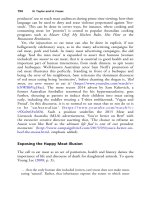The palgrave international handbook of a 213
Bạn đang xem bản rút gọn của tài liệu. Xem và tải ngay bản đầy đủ của tài liệu tại đây (27.81 KB, 1 trang )
208
A. Nurse
Case Study 1: Egg Collecting
Egg collecting is primarily a UK (and arguably English) pursuit with some
origins in schoolboy nature and natural history studies. Richards (1914,
p. 4) wrote ‘probably there is no natural history pursuit which has had
more active and enthusiastic devotees than that which involves the collection of birds’ eggs and the study of nidification in general’. The Royal
Society for the Protection of Birds (RSPB) identifies that ‘collectors can
devote their life to the pursuit of eggs and can become obsessed with the
practice. They usually take the whole clutch of eggs, and may return for a
second clutch. Rare species of birds are often targeted. An egg will rot if the
contents are left inside, so eggs must be ‘blown’. Collectors will take eggs at
every stage of incubation, although freshly laid eggs are preferred as it is
easier to blow out the yolk and the white of the egg’ (RSPB 2009). As this
description illustrates, viable eggs must first be deprived of the yolk, usually
carried out by drilling a small hole in one end and then either flushing out
the contents by blowing them out through a tube, or by inserting a caustic
substance into the shell which dissolves the contents yet leaves the shell
intact. Eggs can then be retained for private display, often in custom-made
cabinets.
Egg collecting thus represents destruction of wildlife with its associated
abuse on wildlife populations and the natural lifecycle and breeding success
of wild birds. Sutherland’s (1973) differential association theory helps to
explain the situation that occurs when potential animal abusers and wildlife
offenders learn their activities from others in their community or social group
(Sutherland 1973). For example, mature egg collectors in the UK argue that
there is no harm in continuing an activity that they commenced legitimately
as schoolboys, as typified by Richards’ (1914) writings. Examination of case
files and newspaper reports on egg collecting confirm that new collectors
continue to be attracted to the ‘hobby’ and learn its ways through interaction
with more established collectors (Nurse 2013a, 2011). Research has identified that communities of egg collectors exist where collecting techniques and
knowledge are shared (Nurse 2013a, pp. 79–80). For example, the demonstration of climbing or egg blowing techniques, identification of bird breeding sites and discussion of display techniques all help novice collectors to
learn their craft. Thus, Sutherland’s (1973) differential association theory
provides a partial explanation for the emergence of new egg collectors who
develop an understanding and appreciation of the activity from those older
and more established egg collectors who impart knowledge and experience of
the activity. Hobby criminals such as egg collectors (Nurse 2013a) are









